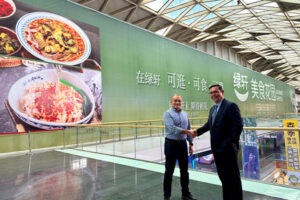BY ALEXANDER OTTO
At our centers alone, the gastronomy turnover rose by 54% between 2010 and 2015: It is no secret that food is an essential feature that differentiates shopping centers from e-commerce. We were surprised to learn recently from our own research that 40% of shopping center customers already choose their shopping destination mainly based on the food options available there. People go primarily where they can meet friends and sit in a comfortable environment where they can enjoy eating out. The importance of food in shopping centers can thus hardly be overestimated.
A few years ago, a big food court hype started. “Add a food court to your center and you will have secured its success for the future or at least the next decade”—that was a rather short-sighted approach in some cases. A shopping center is much more complex than it appears to be. Even if this is sometimes disputed by the public or the media: Every center is unique. Shopping centers can serve very diverse types of customers depending on the city or city district they are located in. They have different customers, different locations, different competitive situations, and different architecture and functional quality. A food court is not the universal answer for every center and it is also not reasonable at every possible location inside. As footfall generators, food courts are often implemented in remote parts of a center, but that doesn’t always work out in the end. Gastronomy is important, but it is usually not the panacea for a center.
Apart from that, it is not only the customer we have to keep in mind. We also have to understand the tenants. The needs of a food retailer are very different from those of, say, a fashion outlet. First of all, there are special technical requirements such as grease interceptors and enhanced ventilation that need to be installed in the center. Some food and beverage concepts also wish for extended opening hours, making it essential that their outlet can be accessed from the outside. In addition, it should be assessed beforehand whether a concept is suitable for a shopping center in the first place. Some providers have to adapt, for example by offering breakfast so they can also generate turnover in the morning. Another very important aspect is the question of the immediate neighbors in the center. Do they complement the offer? For example, do fashion outlets nearby attract a target group that will also be drawn to a fast food chain? No doubt, putting together the perfect branch and tenant mix requires fine tuning by an experienced leasing manager.
Right now, the industry is focusing more on the many new casual dining and fine dining concepts that have more of a high-quality approach and enhance the quality of stay and the general appearance of a center.
Whether it is a new food court or food concepts with individual seating areas: It is vital to focus on ambience and service aspects today. Our customer surveys show that almost two thirds of the visitors ask for special architectural design in the food areas. In contrast, many existing food courts are extremely noisy and are reminiscent of factory canteens or university refectories—with a quality of stay close to zero. Of course, the mix of food and beverage options is the most important aspect for customers, but atmosphere and services like free Wi-Fi, USB charging stations, family zones, and kids’ play areas are equally relevant. Anyone clever enough to go the extra mile to provide all this will reap the benefits.
What is your opinion on this topic? Discuss it with us! Send your opinion to opinion@across-magazine.com






